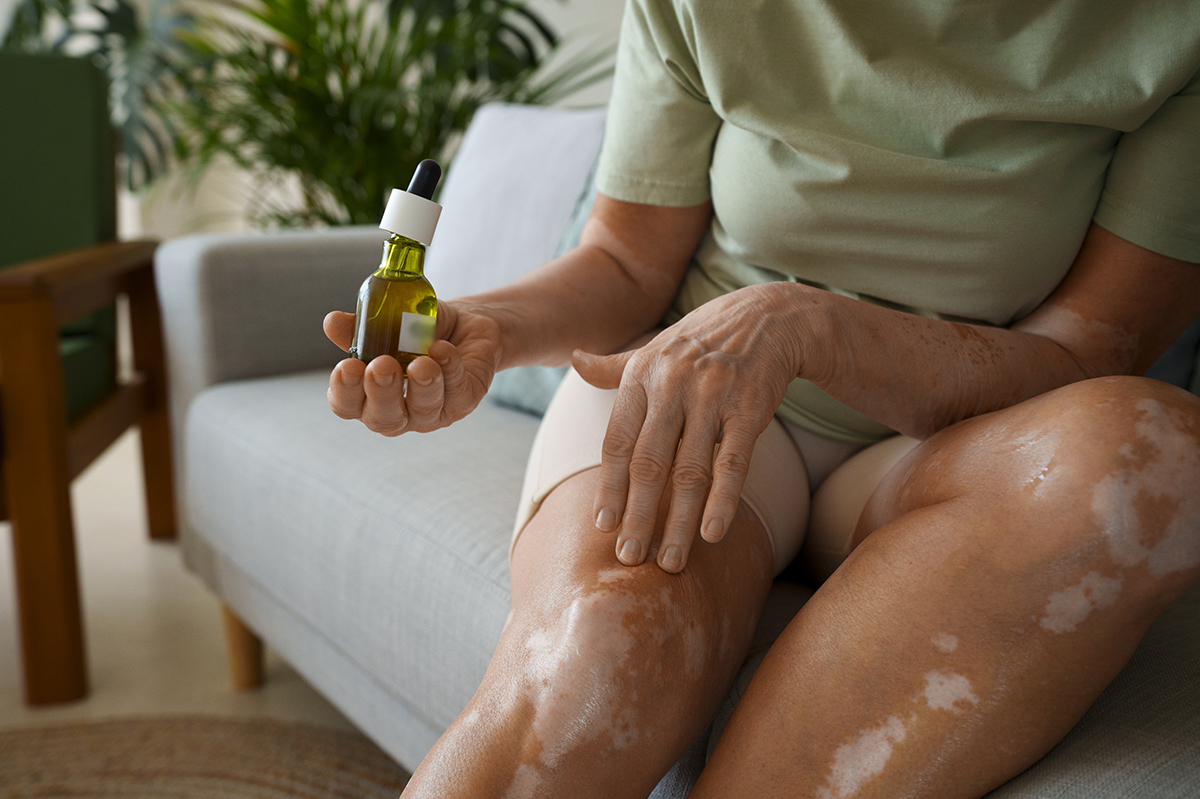Step-by-Step Ayurvedic Approach to Cure Vitiligo Naturally
April 16, 2025
Vitiligo is a skin condition where white patches develop due to the loss of melanin, the pigment responsible for skin color. While modern medicine often resorts to steroid creams and UV therapy, Ayurveda offers a more holistic, root-cause approach by correcting imbalances in the body and rejuvenating skin health.
In this blog, we will explore the step-by-step Ayurvedic process to naturally treat and manage vitiligo effectively.
Understanding Vitiligo from an Ayurvedic Perspective
In Ayurveda, vitiligo is caused by an imbalance of the three doshas, Vata, Pitta, and Kapha, especially Pitta, which is responsible for skin coloration and metabolism. Improper digestion, poor lifestyle, stress, and consumption of incompatible foods can disturb Pitta and Rakta Dhatu (blood tissue), resulting in toxic buildup that manifests as white patches on the skin.
Step-by-Step Ayurvedic Approach to Cure Vitiligo
Step 1: Deep Internal Detoxification
The first and most essential step in Ayurvedic treatment is detoxifying the body to remove accumulated toxins, known as ama.
This cleansing process begins with carefully guided dietary changes that focus on light, easily digestible, and natural foods.
Simultaneously, lifestyle modifications such as following a daily routine and seasonal routine are introduced to support the body’s natural rhythms.
Herbal formulations may also be used to stimulate digestion and aid in eliminating waste.
Once the internal system is purified, the bodily channels become clear, improving the flow of nutrients and energy.
This sets the foundation for effective healing, including restoring skin pigmentation and overall vitality.
Recommended Diet:
Eat light, easily digestible foods like moong dal, steamed vegetables, rice, and khichdi.
Include bitter and astringent tastes, such as neem, karela (bitter gourd), and turmeric.
Drink buttermilk with roasted cumin and rock salt daily it aids digestion and improves skin health.
Consume coconut water and Amla juice regularly to boost immunity and reduce Pitta.
Foods to Avoid: Incompatible food combinations like milk with salty or sour items.
Excessively sour, spicy, oily, or fermented foods.
Seafood, non-vegetarian foods, and alcohol.
Preserved and packaged food that creates Ama (toxins).
Lifestyle Tips:
Avoid excessive exposure to the sun and heat.
Maintain regular sleep and wake times.
Practice yoga and pranayama to reduce stress.
Step 2: Use of Ayurvedic Herbal Medicines
Ayurveda uses a combination of herbs that have blood-purifying, immune-modulating, and melanin-stimulating effects.
Common Herbs and Formulations:
Bakuchi (Psoralea corylifolia): The most effective herb for vitiligo. Its oil is applied externally, and the seeds are consumed internally under supervision. Helps stimulate melanin production and repigmentation.
Neem (Azadirachta indica): Purifies the blood and strengthens the immune system. Neem juice or capsules help reduce autoimmunity.
Guduchi (Tinospora cordifolia): A powerful Rasayana (rejuvenator) that boosts immunity. Helps reduce the spread of vitiligo patches.
Manjistha (Rubia cordifolia): A potent blood purifier. Helps improve skin texture and remove pigmentation issues.
Swasari Ras and Rasayan Churna: Strengthens the respiratory system and boosts immunity to counter autoimmune reactions.
Step 3: External Application of Ayurvedic Oils and Pastes
Topical treatments are vital in stimulating local pigmentation.
Effective Ayurvedic Oils and Remedies:
Bakuchi Oil: Apply on white patches for 15-20 minutes and expose to mild sunlight for natural pigmentation.
Neem Oil + Coconut Oil: Mix and apply to reduce inflammation and irritation.
Turmeric Paste + Mustard Oil: Acts as an anti-inflammatory and helps repigment skin over time.
Wrightia tinctoria (Indrajava) Leaf Paste: An effective local application used in traditional practices.
Siya Ayurveda VitiCalm: VitiCalm Cream targets discoloration caused by vitiligo, helps strengthen the skin’s barrier, and improves resilience over time.
Step 4: Mind-Body Balance – Managing Stress and Emotions
Vitiligo often worsens with emotional triggers like stress, anxiety, or depression. Ayurveda recommends:
Pranayama (Breathing Techniques): Anulom Vilom and Bhramari help calm the mind and reduce oxidative stress.
Meditation & Mindfulness: Regular meditation improves emotional stability and helps the body respond better to treatment.
Herbs like Brahmi and Jatamansi Help soothe the nervous system and improve mental clarity.
How Long Does Ayurvedic Treatment Take?
Vitiligo is a chronic condition, and Ayurvedic treatment takes time, especially because it focuses on root cause healing. Many patients see visible improvement in 3 to 6 months, while full recovery can take longer, depending on the severity and duration of the condition.
Realistic Expectations:
Ayurveda does not offer an overnight cure. However, patience, consistency, and proper supervision provide a natural, side-effect-free, and holistic solution. Thousands of patients worldwide have reversed vitiligo through a dedicated Ayurvedic regimen.
Conclusion:
Vitiligo may be a complex skin condition, but Ayurveda offers a time-tested and profoundly effective pathway to healing. Through detoxification, proper diet, herbal medicines, external applications, and mental wellness practices, one can manage vitiligo naturally and holistically. If you or your loved ones are struggling with vitiligo, consult an experienced Ayurvedic practitioner and begin your journey towards lasting skin health naturally.
Disclaimer:
Always consult a certified Ayurvedic doctor before starting any treatment, especially for internal medication.
 +1 (857) 707 3625
+1 (857) 707 3625 +91 7428 109 528
+91 7428 109 528
